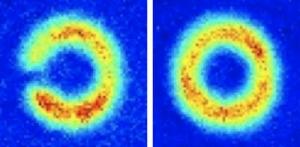Teams from the National Institute of Standards and Technology (NIST) and the University of Maryland (UM) have developed a nontrivial atom circuit, a loop shaped like a donut fabricated from ultracold gas nano-particles floating in a current similar to a circle of electrons in a superconducting wire.
The circuit has an adjustable barrier monitoring the atomic current flow to monitored values making them nontrivial. The research was done at the Joint Quantum Institute, a NIST/UM joint venture.
 NIST's Atom Circuit of Ultracold Sodiuk Gas
NIST's Atom Circuit of Ultracold Sodiuk Gas
Bose-Einstein condensate of sodium atoms, which is an ultracold gas, displays unusual quantum properties. Atomic quantum fluids help develop sensors and gyroscopes. The team developed a stubborn current, which is a particles flow featuring no friction in a Bose-Einstein condensate of sodium nano-particles held by lasers in an optical snare that restricts them in a toroidal or donut shape. Persistent flow represents superfluidity, the superconductive fluid analog. The current circles the ring at target values. A laser beam develops the circuit element. A tunable weak link in the barrier can turn the current around the loop off.
When barrier is strong enough the current flow stops. The atoms accelerate close to the barrier. The atoms cannot flow when the velocity touches a danger spot, putting an end to the circulation.
Source: http://www.nist.gov/